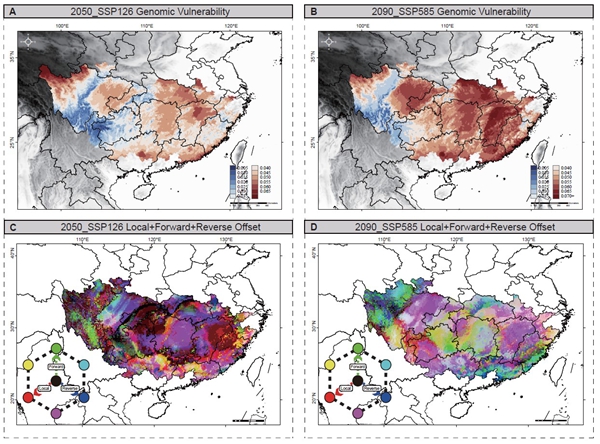
A research team led by Prof. LI Ming from the Institute of Zoology of the Chinese Academy of Sciences, collaborating with scientists from Sichuan University and Anhui University, has published a study in Science Advances that offers new insights into species conservation amid climate change—warning that Tibetan macaques may be more vulnerable than currently recognized.
In this study, the researchers identifies two distinct genetic groups of Tibetan macaques: an eastern group, spanning populations in Anhui's Huangshan, Fujian's Wuyishan, and Hunan's Mangshan; and a western group, including populations in Sichuan, Yunnan's Wumengshan, and Guizhou's Fanjing Mountain. Among these, the Huangshan population stands out for its low genetic diversity and high inbreeding, factors that could weaken its ability to adapt to environmental shifts, researchers note.
Using the Pairwise Sequentially Markovian Coalescent (PSMC) method, the team discovered that both groups have been shaped by historical climate fluctuations, which triggered sharp declines in their effective population sizes. Further investigation into recent population dynamics, via GONE analysis, uncovered a severe population bottleneck affecting both groups around 1,100 years ago.
The study has shown that the eastern population has fewer highly deleterious mutations compared to the western population, but it exhibits a higher number of moderately deleterious mutations. It is believed that the eastern group may be primarily influenced by a combination of genetic drift and purifying selection. Although purifying selection typically decreases the frequency of highly deleterious mutations, some moderately deleterious mutations may randomly drift to higher frequencies, which can undermine the effects of purifying selection. Consequently, this study suggests that the random fixation of moderately deleterious mutation sites could result in long-term damage to adaptability in response to future climate change.
Projections of ecological and genomic vulnerability under future climate scenarios highlight temperature fluctuation as a key factor influencing the macaques' habitat choices. The study warns that as climate change intensifies, the Qinling region may serve as a critical climate refuge for western populations, but eastern groups could lose significant suitable habitats due to fragmented landscapes.
Furthermore, the researchers employed models including gradient forest (GF) and Generalized Dissimilarity Modeling (GDM) and revealed that eastern populations—particularly the Huangshan group—face a higher "genetic offset," meaning their genetic traits may be poorly matched to future conditions. Coupled with the Huangshan population's inbreeding, low diversity, and high ecological vulnerability, the researchers caution that it could confront severe climate-related risks.
The findings suggest the International Union for Conservation of Nature (IUCN) Red List may underestimate threats to Tibetan macaques, prompting the team to recommend upgrading their protection status. For eastern populations, especially the Huangshan group—limited by fragmented habitats and unable to migrate to more suitable areas—the study calls for ecological corridors linking Huangshan, Mangshan, and Wuyishan National Parks to boost habitat connectivity and strengthen conservation efforts.

Predicted genetic offset for future climate change under the SSP 1-2.6 scenario in 2050 and the SSP 5-8.5 scenario in 2090. (Image by Prof. LI Ming's Lab)

86-10-68597521 (day)
86-10-68597289 (night)

52 Sanlihe Rd., Xicheng District,
Beijing, China (100864)

